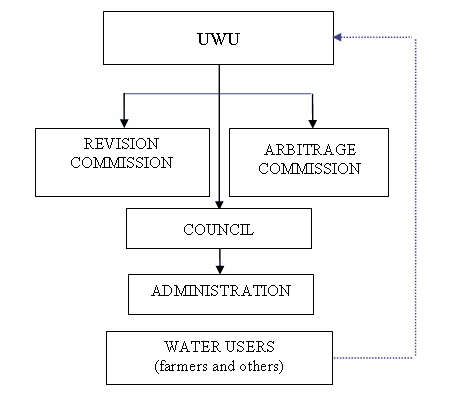
So that the people could solve managerial tasks and influence the management process as a whole, they should unite in an entity, for instance in a water user association (WUA) (Fig.).

Functional diagram of WUA
As is well-known, new types of water organizations – non-governmental (community-based) unions of water users, with WUAs as the most spread, have been formed in all the countries of Central Asia, except for Turkmenistan. WUAs are needed so that the public (water users) were able to express their opinion.
The entities of water supply & water use + land reclamation governance in the form of a General Water User Assembly (GWUA) and WUA Council (Board) serve as participatory mechanisms.
The typical responsibilities of a WUA Council are as follows:
• determine an organizational set-up of the WUA Administration and employ a Director of WUA;
• support the Director in staffing and setting of employment duties;
• give advices to the Director when employing Administration staff;
• give advice in drafting operation and maintenance plan and then approve it;
• give advice to the Director on modernization of the irrigation system and on purchase of equipment and supplies;
• advise the Director during formulation of the WUA’s budget and financial management system and approval of the budget and the system;
• advise the Director on training needs assessment;
• advise the Director on performance monitoring and information system management.
Members of the WUA Council often do not know that they have the above functions.
The key problem related to WUA that is poorly understood on the top (by decision makers) and the grassroots (by farmers) level is the poor capacity and, consequently, low performance of WUA Councils.
The case is that due to weak motivation, the Directors of WUAs, i.e. heads of WUA’s executive body, are the key figures in WUAs instead of Chairmen of WUA Councils. In most cases, farmers consider WUAs as subordinates of public water agencies rather than as their own organizations that are to provide water services to them. This is partially the reason of a CA paradox of very low water fee collection (50%) for WUA’s services.
Another shortcomings of WUAs that are unavoidable at early development stages are as follows:
• currently, WUAs, as a rule, are mono-functional entities that integrate farms in terms of water.
• Payments for WUA services are hectare based. This does not contribute to stronger interdependence between provides (WUA) and users (farms) of water services. As a consequence, there are no incentives for water saving and better collection of fees for water services provided by both WUA itself and public water agencies.
Thus, to increase WUA’s capacities, it is necessary to
• Enhance the WUA Council (Board) through reputable representatives of water users, local self-governance entities and water-management organizations.
• Increase the role and credibility of the WUA Council’s Chairman.
• Transfer to volume-based payment for irrigation services.
• Gradually extend WUA’s functions so that WUAs evolved from mono-functional into multi-functional entities.
To this end, in Uzbekistan the functions of WUA Director are currently transferred to WUA Council’s Chairman since division of WUA governance and management functions is advisable for higher-degree developed WUAs.
Author: Mirzaev N.N., SIC ICWC